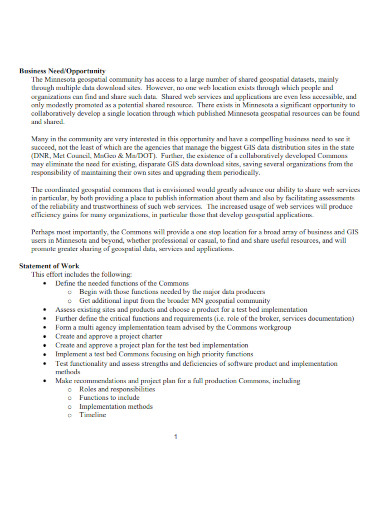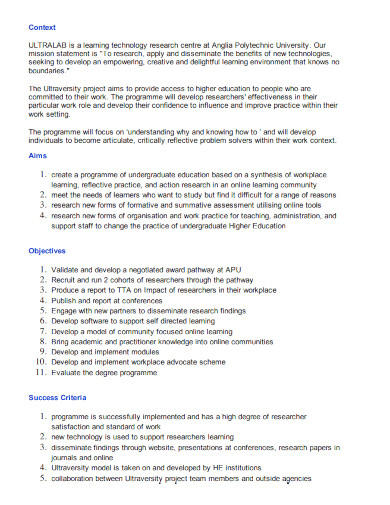One of the best practices before starting any important project is to create an in-depth outline of a project plan. This plan serves as a guide for the execution and control of the project as well as provides all necessary information such as the project’s goals, objectives, scope of work, milestones, resources, and risks. This information will help in performing effective project management, monitoring, and controlling the project’s progress.
4+ Project Plan Outline Samples
1. Project Management Plan Outline
2. Life Cycle Project Plan Outline
3. Project Plan Proposal Outline
4. Outline For Project Management Workshop
5. Ultraversity Project Plan Outline
What is a Project Plan?
Project planning is a method used to determine how to accomplish a project proposal within a given period of time and provides the defined stages and the appropriate resources to be used. The activities in a project plan are divided into steps which include setting measurable and actionable business goals, identifying deliverables, schedule management, and planning tasks. Other supporting plans include human resources, communication plans, and risk management. With a project plan template, managers can compile all the guidelines and procedures that their team will need to accomplish the project.
How to Create a Project Plan Outline?
A project plan is one of the key factors of a successful project and is the most essential document to be created when you are starting a new business project, regardless of its type or size. A project plan is used to record and communicate stakeholder products and project expectations, control schedule and delivery, and calculate and efficiently manage the risks that come with the project. The tools used for the project’s schedule management include Gantt charts and PERT charts.
Step 1: Provide the Definition of the Project
Key stakeholders have the authority and influence to dictate the success of the project and their requirements must be met. Communicate with them to get aligned, define your business goals, and determine the relevance of the project.
Step 2: Include the Project Scope
After outlining the project, aligning your tasks with your goals, and buy-in from your team, you can now provide details on the scope of your project. Determine your deliverables and define the tasks that should be accomplished as well as the time it will take to be completed.
Step 3: Create a Project Schedule
The Gantt chart is an effective tool to easily visualize your project timeline which gives you visibility of your project’s progress, the scope of work, and dependencies. For easier reporting and resource management, create a list of subtasks so you can break up larger tasks into smaller ones.
Step 4: Provide the Description of the Roles
After selecting your tools and establishing your budget plan, create a chart to determine who will do which tasks to complete the project. Make sure to provide clear definitions of the roles and responsibilities of each people involved.
Step 5: Define your Communication Plan
The factors that contribute to stress in a workplace are inefficient communication and collaboration. You can reduce this by storing all project materials and pieces such as assets, conversations, submission dates, tasks, updates, and reports in one centralized place.
FAQs
What documents does a project plan include?
The documents included in a project plan include the project charter which provides the overview of the project, statement of work, work breakdown structure, and the project plan which is divided into sections to cover scope management, quality management, risk analysis, resource management, stakeholder management, schedule management, and change management plan.
What are the phases of a project’s life cycle?
A project life cycle has five phases which are Initiation which defines the project’s goals and objectives, Planning, Execution where project deliverables are accomplished, Monitoring and Controlling, and Closure in which the stakeholders receive the final deliverable.
What are the commonly used documents in project planning?
When planning a project, the commonly used documents are the project budget template, change request template, change order template, scope management plan, cost management plan, and risk management plan.
A project plan is an important document to track and monitor project requirements, functionalities, scheduling, and budget management. With this document, companies can formally document and establish detailed project requirements such as human and financial resources, communication roadmap, projected timeframes, and risk management. A project plan is also a formal contract agreement between a project procurer and a developer.
Related Posts
FREE 9+ 30-Day Marketing Plan Samples in PDF | MS Word | Apple Pages | Google Docs
FREE 3+ Sales Team Action Plan Samples in PDF | MS Word | Apple Pages | Google Docs
Marketing Plan For Small Business Samples
FREE 7+ Fashion Business Plan Samples in PDF
FREE 10+ Sprint Planning Samples In MS Word | Google Docs | PDF
FREE 10+ Wedding Planning Samples in MS Word | Apple Pages | Powerpoint | PDF
FREE 9+ Monthly Study Planner Samples in PSD | Illustrator | InDesign | PDF
FREE 9+ Sample Curriculum Planning Templates in PDF | MS Word
FREE 10+ Teacher Development Plan Samples in MS Word | Google Docs | Apple Pages | PDF
FREE 10+ Basketball Practice Plan Samples in PDF
FREE 12+ School Business Plan Samples in PDF | MS Word | Apple Pages | Google Docs
FREE 7+ Client Strategic Plan Samples in PDF | MS Word
FREE 11+ Trucking Business Plan Templates in PDF | MS Word | Google Docs | Pages
FREE 7+ Small Hotel Business Plan Samples PDF | MS Word | Apple Pages | Google Docs
FREE 14+ Bakery Business Plans in MS Word | PDF | Google Docs | Pages





